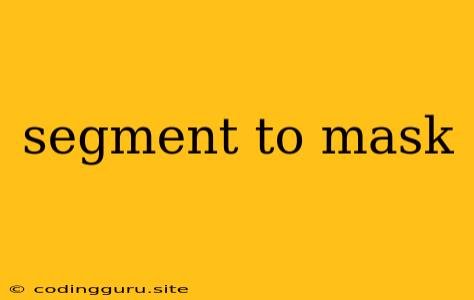Understanding "Segment to Mask" in Image Processing
In the realm of computer vision and image processing, "segment to mask" is a fundamental concept that plays a crucial role in various applications. It essentially refers to the process of converting a segmented image into a mask, which can then be used for various downstream tasks.
What is Segmentation?
Before diving into "segment to mask," let's clarify what image segmentation is. Imagine you have an image of a busy street scene. Segmentation is the process of dividing this image into meaningful regions, separating objects of interest from the background. This can be done based on different criteria like color, texture, shape, or even object recognition using deep learning techniques.
What is a Mask?
A mask, in image processing, is a binary image (an image with only black and white pixels). This image acts like a stencil, allowing us to focus only on specific areas of the original image. In a "segment to mask" process, the mask represents the segmented regions.
The "Segment to Mask" Process:
The "segment to mask" process is relatively straightforward. It involves the following steps:
- Segmentation: Perform image segmentation using your preferred method (e.g., thresholding, clustering, edge detection, deep learning models).
- Mask Generation: Based on the segmentation results, create a binary mask. This mask assigns a value of 1 to pixels belonging to the segmented regions and 0 to the rest.
Example:
Let's say we have a picture of a cat. Using a deep learning segmentation model, we identify the cat as a separate object. In the "segment to mask" process, we would create a mask where all pixels corresponding to the cat are marked as 1 (white), and the rest of the image (background) is marked as 0 (black).
Applications of "Segment to Mask":
"Segment to mask" is a widely used technique in numerous applications, including:
- Object Detection: By creating masks around objects, we can easily identify and locate them in images.
- Image Editing: Masks allow for targeted edits within images, such as replacing specific areas or applying special effects.
- Medical Imaging: Segmentation and masking are critical in medical image analysis, enabling the identification of tumors, organs, and other relevant structures.
- Autonomous Driving: Self-driving cars rely on segmentation and masking to understand their surroundings and recognize objects like pedestrians and traffic signals.
- Robotics: Robots often use "segment to mask" to isolate objects of interest for manipulation or navigation.
How to Implement "Segment to Mask":
Many libraries and tools are available to perform "segment to mask" operations in various programming languages like Python, C++, or MATLAB. Here's a simple example using Python and the OpenCV library:
import cv2
# Load the image
image = cv2.imread("cat.jpg")
# Perform segmentation (this is just a placeholder)
segmented_image = cv2.cvtColor(image, cv2.COLOR_BGR2GRAY)
thresh = cv2.threshold(segmented_image, 127, 255, cv2.THRESH_BINARY)[1]
# Create the mask from the segmentation result
mask = thresh
# Display the mask
cv2.imshow("Mask", mask)
cv2.waitKey(0)
Conclusion:
"Segment to mask" is a powerful tool in image processing, enabling us to effectively isolate specific regions of interest within an image. This technique is fundamental to many applications, from object detection and image editing to advanced tasks like autonomous driving and medical image analysis. By understanding this concept, you gain a deeper understanding of how computers can "see" and interpret images.
